7 books about American Family
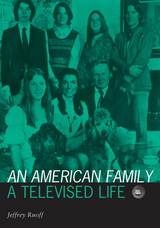
American Family
A Televised Life
Jeffrey Ruoff
University of Minnesota Press, 2001
The first in-depth look at this pioneering "reality TV" documentary.
Before 1973, the Loud family of Santa Barbara, California, lived in the privacy of their own home. With the airing of the documentary An American Family, that "privacy" extended to every American home that had a television in it-and there was no going back to the happy land of Beaver, Donna Reed, and Father Knows Best. This book is the first to offer a close, sustained look at An American Family-the documentary that blurred conventions, stirred passions among viewers and reviewers, revised impressions of family life and definitions of private and public, and began the breakdown of distinctions between reality and spectacle that culminated in cultural phenomena from The Oprah Winfrey Show to Survivor.
While placing Craig Gilbert's innovative series in the context of 1970s nonfiction film and television, Jeffrey Ruoff tells the story behind An American Family from conception to broadcast, from reception to long-term impact. He reintroduces us to the Louds as intimate details of their daily lives, from one child's dance recital to another's gay lifestyle to the parents' divorce proceedings, unfold first before the camera and then before American viewers, challenging audiences to think seriously about family, marital relations, sexuality, affluence, and the American dream. In the documentary's immediate impact-on both producers and viewers of media-Ruoff uncovers the roots of new nonfiction forms including confessional talk shows like Oprah, first-person documentary films like Ross McElwee's acclaimed Sherman's March, and reality TV programs such as The Real World, Survivor, and Big Brother.
A comprehensive production and reception study, Ruoff's work restores An American Family to its rightful, pioneering place in the history of American television.
Jeffrey Ruoff is a film historian, documentary filmmaker, and assistant professor of film and television studies at Dartmouth College. He is co-author (with Kenneth Ruoff) of The Emperor's Naked Army Marches On (1998).
[more]
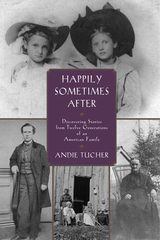
Happily Sometimes After
Discovering Stories from Twelve Generations of an American Family
Andie Tucher
University of Massachusetts Press, 2014
For more than four hundred years, members of the author's family have been telling stories about their American lives. They have told of impassioned elopements and heart-breaking kidnaps, of hairbreadth escapes and shocking murders, of bigamists, changelings, patriots, Indians, fires, floods, and how the great-grandmother of Chief Justice John Marshall married the pirate Blackbeard by mistake.
In this beautifully written work, Andie Tucher considers family stories as another way to look at history, neither from the top down nor the bottom up but from the inside out. She explores not just what happened—everywhere from Jamestown to Boonesborough, from the bloody field at Chickamauga to the metropolis of the Gilded Age—but also what the storytellers thought or wished or hoped or feared happened. She offers insights into what they valued, what they lost, how they judged their own lives and found meaning in them. The narrative touches on sorrow, recompense, love, pain, and the persistent tension between hope and disappointment in a nation that by making the pursuit of happiness thinkable also made unhappiness regrettable.
Based on extensive research in archives, local history societies, and family-history sources as well as conversations and correspondence, Happily Sometimes After offers an intimate and unusual perspective on how ordinary people used stories to imagine the world they wished for, and what those stories reveal about their relationships with the world they actually had.
In this beautifully written work, Andie Tucher considers family stories as another way to look at history, neither from the top down nor the bottom up but from the inside out. She explores not just what happened—everywhere from Jamestown to Boonesborough, from the bloody field at Chickamauga to the metropolis of the Gilded Age—but also what the storytellers thought or wished or hoped or feared happened. She offers insights into what they valued, what they lost, how they judged their own lives and found meaning in them. The narrative touches on sorrow, recompense, love, pain, and the persistent tension between hope and disappointment in a nation that by making the pursuit of happiness thinkable also made unhappiness regrettable.
Based on extensive research in archives, local history societies, and family-history sources as well as conversations and correspondence, Happily Sometimes After offers an intimate and unusual perspective on how ordinary people used stories to imagine the world they wished for, and what those stories reveal about their relationships with the world they actually had.
[more]
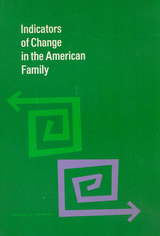
Indicators of Change in the American Family
Abbott Lamoyne Ferriss
Russell Sage Foundation, 1970
Provides a selection of existing and new measures of family change. The statistical time series are presented and organized around the topics of marriage, marital status, households, fertility, divorce, dependency, work and income, and poverty. The series selected for inclusion were chosen because of an apparent or assumed significant change which they displayed. They are illustrated by graphs and accompanied by a brief commentary. The statistical series are numbered in an appendix, and sources of the data are cited at the foot of the page of commentary.
[more]

Lawfully Wedded Husband
How My Gay Marriage Will Save the American Family
Joel Derfner
University of Wisconsin Press, 2013
When Joel Derfner's boyfriend proposed to him, there was nowhere in America the two could legally marry. That changed quickly, however, and before long the two were on what they expected to be a rollicking journey to married bliss. What they didn't realize was that, along the way, they would confront not just the dilemmas every couple faces on the way to the altar—what kind of ceremony would they have? what would they wear? did they have to invite Great Aunt Sophie?—but also questions about what a relationship can and can't do, the definition of marriage, and, ultimately, what makes a family.
Add to the mix a reality show whose director forces them to keep signing and notarizing applications for a wedding license until the cameraman gets a shot she likes; a family marriage history that includes adulterers, arms smugglers, and poisoners; and discussions of civil rights, Sophocles, racism, grammar, and homemade Ouija boards—coupled with Derfner's gift for getting in his own way—and what results is a story not just of gay marriage and the American family but of what it means to be human.
[more]
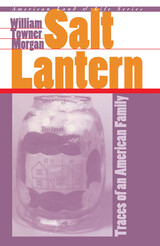
Salt Lantern
Traces of an American Family
William Towner Morgan
University of Iowa Press, 1997
As a child growing up in Pipestone, Minnesota, in the 1930s, William Morgan marveled over his great-grandmother's salt-filled chimney lantern. Full of sea salt and mementos and drawings that commemorated her British home and her journey to America in 1855, this Victorian artifact became the inspiration both for Morgan's pilgrimage to find the original salt lantern and, after many journeys both external and internal, for this multifaceted family history.
Morgan began his research by visiting England and Scotland, then traveled to Vermont, Wisconsin, Minnesota, Iowa, and North Dakota searching for the buildings and landscapes related to his mother's ancestors. Tracing his father's family took him to Ireland, where he discovered the thatched-roof house in which his grandmother was born. By studying his family's houses, farm buildings, landforms, letters, and heirlooms, Bill Morgan tells the stories of his ancestors' lives. By adding fresh memories written by his sister and brothers as well as journals and other family documents, he builds upon these stories to create a full life of an American family.
[more]
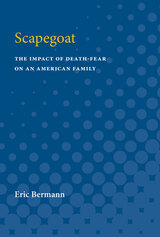
Scapegoat
The Impact of Death-Fear on an American Family
Eric Bermann
University of Michigan Press, 1973
Roscoe A. was eight years old when psychologist Eric Bermann first met him and his family. In kindergarten Roscoe was considered highly creative, but he was also evaluated by his teachers as a potentially dangerous and destructive child capable of uncontrolled aggression toward other children. His parents denied the report. To them, Roscoe was a quiet, well-behaved boy. In the second grade, over the objections and confusions of his parents, Roscoe was finally removed from public school and admitted to a day treatment facility where he could receive psychotherapy. Progress was minimal. After a year of effort there still was no agreement about "Roscoe's problems." Mental health professionals despaired. They deemed his parents "unworkable," and labelled them "deniers" of their son's destructive behaviors. In turn the parents blamed the professionals for therapeutic incompetencies and failure to help Roscoe, who, after all, "was never a problem at home." The one alternative to terminating the therapeutic effort was the possibility of obtaining new data and fresh insights into the dilemma. It was at this point that Dr. Bermann, a clinical researcher embarked on the study of family interaction, was consulted. He immediately negotiated with the family to visit them in their home where he might observe their interactions in situ. He hoped, with them, that in so doing he might shed some light on the discrepancy in reports about Roscoe's behavior. Dr. Bermann visited the family and recorded his observations regularly and in detail throughout the next year. His analysis of these observations has resulted in this startling book--a research account that is both stunning in the originality of its method and searing in its documentation of an American family in crisis. In the course of his visits Dr. Bermann discovered the family's central and well-concealed "secret": Roscoe's father had been for years in precarious health and now was on the brink of death. Although the family nev
[more]
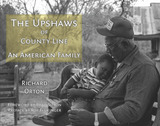
The Upshaws of County Line
An American Family
Richard Orton
University of North Texas Press, 2014
READERS
Browse our collection.
PUBLISHERS
See BiblioVault's publisher services.
STUDENT SERVICES
Files for college accessibility offices.
UChicago Accessibility Resources
home | accessibility | search | about | contact us
BiblioVault ® 2001 - 2024
The University of Chicago Press









